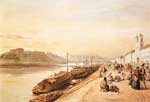|
As so often happens with a strong monarch, his successors found him a hard act to follow. Struggles for the throne ensued, and, inevitably, disaster eventually struck. The boy king Lajos II was drowned in 1526 while retreating from the infamous Battle of Mohács (in southern Hungary), where the  Hungarians were crushed by the Ottoman army led by Suleiman the Magnificent. Less than twenty years later the Ottomans had pushed west to Buda, which they overran in 1541. Hungary was then carved up into three parts with the Ottomans ruling the south and east to the Danube, Ferdinand Habsburg (brother of the Holy Roman Emperor Charles V) grabbing the north and west, and Transylvania (now part of Romania) becoming a vassal Ottoman state which was allowed a certain amount of internal political independence.The Turks remained in Buda for 140 years. Period woodcuts show a city bristling with minarets – all have now vanished. Finally driven out in 1686 by the Habsburg armies of Leopold I, led by Eugene of Savoy and Charles of Lorraine, their few surviving relics include a handful of Turkish baths and a small Muslim mausoleum on the slopes above Margaret Bridge. Hungarians were crushed by the Ottoman army led by Suleiman the Magnificent. Less than twenty years later the Ottomans had pushed west to Buda, which they overran in 1541. Hungary was then carved up into three parts with the Ottomans ruling the south and east to the Danube, Ferdinand Habsburg (brother of the Holy Roman Emperor Charles V) grabbing the north and west, and Transylvania (now part of Romania) becoming a vassal Ottoman state which was allowed a certain amount of internal political independence.The Turks remained in Buda for 140 years. Period woodcuts show a city bristling with minarets – all have now vanished. Finally driven out in 1686 by the Habsburg armies of Leopold I, led by Eugene of Savoy and Charles of Lorraine, their few surviving relics include a handful of Turkish baths and a small Muslim mausoleum on the slopes above Margaret Bridge.
|
 After this followed a period of extensive rebuilding; this is the period of most of the Baroque buildings still extant today. The enlightened despotism of Maria Theresa (1717-1780) and her son Joseph II (1741-90) saw the growth of both Buda and Pest. After this followed a period of extensive rebuilding; this is the period of most of the Baroque buildings still extant today. The enlightened despotism of Maria Theresa (1717-1780) and her son Joseph II (1741-90) saw the growth of both Buda and Pest. |
|
|